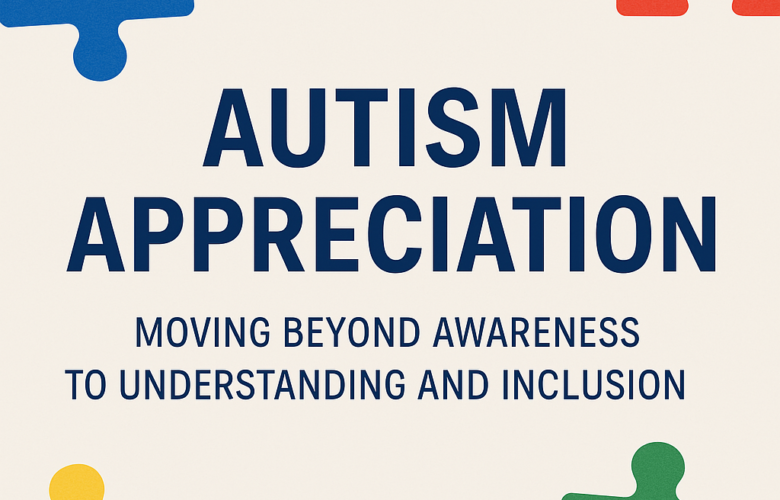April is often marked with blue lights, puzzle pieces, and talk of “awareness.” But in recent years, a growing number of autistic individuals and advocates have called for a shift—from simply raising awareness to fostering appreciation, acceptance, and understanding.
Why the change in language? Because awareness alone can fall short. Awareness can mean knowing autism exists. Appreciation means valuing autistic people for who they are.
In this article, we’ll take a deeper dive into what autism is (and isn’t), challenge some common myths, explore the beauty and richness of autistic ways of being, and share resources to help you learn more, advocate better, and connect more meaningfully.
What Is Autism?
Autism—often referred to clinically as Autism Spectrum Disorder (ASD)—is a neurodevelopmental difference that affects how a person perceives the world, processes information, communicates, and interacts with others.
But defining autism only by challenges misses the full picture. Autism is not a disease or defect. It’s a neurological variation—a difference in brain wiring that can bring both difficulties and unique strengths.
Autistic people may:
- Process sensory information differently (sights, sounds, textures, etc.).
- Communicate in ways that are less typical (including nonverbal communication).
- Prefer routines or structured environments.
- Have passionate, focused interests.
- Interpret social cues in unique ways.
- Express emotions differently—but deeply.
Every autistic person is different, which is why we refer to the “spectrum.” But this isn’t a single line from “less autistic” to “more autistic.” Instead, it’s more like a color wheel of traits and experiences, with each individual showing a different combination.
From Misunderstanding to Misrepresentation
For many years, autism has been portrayed through a narrow, often medicalized lens—one that focuses heavily on deficits. This perspective has fueled pity, fear, and stigma.
Early awareness campaigns often framed autism as a tragedy or burden. Autism “warrior” narratives cast parents as soldiers and children as lost to a mysterious enemy. Popular media has favored limited portrayals—like the savant character (à la Rain Man)—which erase the diversity of the autistic population and set unrealistic expectations.
These outdated portrayals have real consequences:
- Autistic children are often subjected to harmful therapies aimed at “normalizing” them.
- Autistic adults are overlooked in services, employment, and healthcare.
- Autistic people of color face increased misdiagnosis or underdiagnosis.
- Many autistic individuals are left feeling alienated from their own identities.
It’s time we do better—not by “fixing” autistic people, but by fixing the way we see autism.
Appreciation Means Listening to Autistic Voices
Appreciation starts with respect—and respect starts with listening.
Autistic people have been speaking out for decades. They’ve shared their experiences, insights, challenges, and joys. They’ve created movements like #ActuallyAutistic and Autistic Pride Day. They’ve asked us to move away from the idea that they are broken and instead to see them as whole.
Some key points raised by autistic self-advocates include:
- “Nothing about us without us.” Autistic voices should lead conversations about autism.
- “Presume competence.” Don’t assume inability just because someone communicates differently.
- “Acceptance over awareness.” Awareness can objectify; acceptance humanizes.
- “Autism is not a puzzle to solve.” The puzzle piece symbol is often criticized. Many prefer symbols like the infinity loop (for neurodiversity) or rainbow infinity (for autistic pride).
Celebrating Autistic Strengths
Appreciation also means recognizing the value that autistic people bring—to families, communities, workplaces, and the world.
Autistic individuals can offer:
- Unique problem-solving skills.
- Strong attention to detail.
- Authentic honesty and integrity.
- Creative, out-of-the-box thinking.
- Deep expertise in focused areas.
- Sensory attunement others might miss.
Many of history’s great thinkers, artists, and scientists likely fell somewhere on the spectrum—though they may not have had a diagnosis at the time. Today, autistic individuals continue to make profound contributions across every field.
But their success doesn’t come from “overcoming autism.” It comes from being supported as autistic people—not in spite of it.
Inclusion and Support: What We Can All Do
True appreciation goes beyond admiration—it translates into action.
Here are some steps we can all take:
- Learn from autistic people. Follow autistic creators, bloggers, and advocates.
- Use respectful language. Many prefer identity-first language (“autistic person”) over person-first (“person with autism”). When in doubt, ask.
- Challenge myths. Speak up when you hear stereotypes or misinformation.
- Make space. Design environments (workplaces, schools, public spaces) with sensory and communication accessibility in mind.
- Support inclusion. Advocate for neurodiverse hiring practices, education accommodations, and inclusive policy-making.
- Model acceptance. Especially for children—teach them early that differences are natural and valuable.
A Final Note: Autism Is a Natural Part of Human Diversity
Autistic people aren’t failed versions of “normal.” They are fully human, deeply feeling, wonderfully diverse individuals with their own ways of thinking, communicating, and being in the world.
This Autism Appreciation Month, let’s go beyond awareness. Let’s listen, learn, and grow. Let’s build a world where autistic people are not just accepted—but valued, included, and celebrated.


